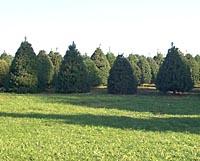Buyers Beware When Shopping for a 'Fresh' Christmas Tree
Buyers Beware When Shopping for a 'Fresh' Christmas Tree


Photo: Aimee Nielson
Kentuckians who think they’re buying “fresh” when they buy a real Christmas tree this holiday season might want to think again.
Many of the evergreens found on Christmas tree lots are cut down in October so they can be shipped to Kentucky from states as far away as Oregon. And that means they stand a good chance of drying out before the holiday festivities even begin.
“Some species are more susceptible (to drying out) than others, but it is a common problem,” said Deborah B. Hill, Extension professor of forestry at the University of Kentucky College of Agriculture. “It’s definitely buyer beware.”
Contrary to popular belief, the problem with a dried-out Christmas tree is not that it is a fire hazard, Hill said. In fact, according to the National Christmas Tree Association, only one-tenth of 1 percent of residential fires involves a Christmas tree.
Rather, the problem is an aesthetic one. When a Christmas tree becomes dry, it loses its needles. In addition to a bare-looking tree, “I don’t think anybody really appreciates a room with needles all over it,” Hill said.
For the freshest Christmas tree, Hill recommends that people cut their own at a Christmas tree farm or find local growers who sell their cut trees wholesale. A listing of growers is available online athttp://www.kychristmastrees.com.
But when that’s not an option, she said it’s best to buy a cut tree as early as possible – even if you don’t plan to put the tree up until Christmas Eve.
“Wind and sun will act to dry them out, and almost never do you find on the lot that they are in water or that they’re protected from wind or sun,” she said. “What I would do is put it either in an enclosed porch or in a garage. It could even go to the basement, if you have a basement.”
She recommends placing a fresh cut on the tree stem – removing as much as 1 to 2 inches if possible – then placing the tree in a bucket of warm water until it’s time to put it inside the house. The warm water helps get the sap flowing and opens up the water conducting channels in the wood.
There are also precautions buyers can take before buying a tree to ensure its freshness. First and foremost, Hill encourages consumers to ask questions.
“It’s absolutely legitimate to ask where the tree has come from and when they received it,” she said. “Ask all the questions up front and if they can’t answer them, then it’s something you should be aware of, too.”
Then, while holding a tree upright, give the stem a solid thump on the ground to observe the needles that fall out. If brown needles fall out, it’s OK, but if green needles fall out, then it’s too dry, Hill said.
Consumers can also take a green needle from a tree and bend it between thumb and forefinger. If it snaps rather than bends, that’s another sign the tree might be too dry.
“So those are quick and dirty things people can check when they’re purchasing trees,” Hill said.
Once it’s time to bring the tree inside to decorate, it’s important to remember to place it in a spot where it will not be exposed to a heat source – stoves, registers, fireplaces and radiators. And be sure to keep it watered, using a tree stand that holds up to a gallon of water, Hill advised.
Hill said one longtime Kentucky Christmas tree grower uses a solution of 1 cup of corn syrup plus 3 tablespoons of liquid bleach and 1 gallon of water. Hill, likewise, recommends this “recipe,” saying the bleach thins out or removes the sticky pitch from the tree’s water-conducting channels, which allows the water to get into the tree. The corn syrup provides carbohydrates.
“This combination should help the needles stay on your holiday tree,” she said.
Whether people choose a locally grown Christmas tree or a cut tree from a neighborhood lot, Hill encourages them to choose carefully.
“Mainly, the buyer should pay attention to what they’re doing,” she said. “They’ll probably get what they pay for. The cheaper the tree is, probably the poorer the quality it is and the greater likelihood it will dry out quicker.”
